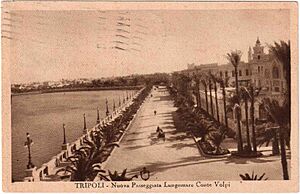Italian Tripoli facts for kids
Tripoli was once the main city and capital of a place called Italian Libya. This was during the first half of the 1900s. Italy controlled Italian Tripoli from 1911 until 1943. After World War II, it officially stopped being an Italian territory in 1947. People in Italy called it "Tripoli italiana," and its residents were known as "Tripolini."
Contents
How Tripoli Became Italian
In 1911, Italy and the Ottoman Empire had a war called the Italo-Turkish War. During this war, the Italian Kingdom took control of Tripoli. On September 28, 1911, Italian ships arrived near Tripoli. About 1,500 Italian sailors quickly took over the city. Many local people welcomed them.
After the war, a peace treaty was signed in 1912 in a place called Ouchy. In this treaty, the Ottomans agreed that Italy now ruled Tripoli. Italy first said the area around Tripoli would be independent. However, Italy slowly took more control of the region. Italians called this area "Tripolitania."
Italian Rule and Growth
At first, Tripoli and its surrounding area were part of a larger Italian colony. But from 1927 to 1934, Tripoli was a separate colony. Then, in 1934, all Italian lands in North Africa joined together. They formed one big colony called "Italian Libya."
In 1937, the governor Italo Balbo started a plan to bring many Italians to Libya. Most of these new settlers were farmers. They were known as the "Ventimilli." Some of them made their homes in the Tripoli area. By the end of 1937, Tripoli had about 108,240 people. About 39,096 of them were Italians.
When World War II began, Tripoli had 111,124 people. About 41,304 of these were Italians. This meant Italians made up 37% of the city's population. There were also nearly 18,000 Jewish people living in the Tripoli area.
After Italy took over Libya in 1911, Jewish people saw many improvements. They had better education and economic opportunities. At that time, about 21,000 Jewish people lived in the country. Most of them were in Tripoli. In the late 1930s, some anti-Jewish laws were slowly put into place. However, by 1941, Jewish people still made up one-fifth of Tripoli's population. They also had 44 synagogues, which are places of worship.
The city grew a lot under Italian rule. New systems were built for sewage. New hospitals and schools were opened. The city also got new roads and buildings. A new airport was built, and the seaport became much larger.
Tripoli During World War II
In 1941 and 1942, Tripoli's population grew even more. It reached almost 150,000 people. This happened because many Italians from other cities, like Benghazi, moved to Tripoli. They were seeking safety from British army attacks during World War II. Because of this, Tripoli became a city with mostly Christian people. This was the first time this had happened since the Arab conquest in 643 AD.
After World War II ended, many Italians started to leave Tripoli. Today, only a few Italians still live in the city.
Related Pages


